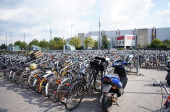
The European housing market is grappling with a multifaceted crisis, characterized by soaring rents, high interest rates, and a severe shortage of available homes. This crisis has not only
placed immense financial pressure on renters and potential buyers but has also contributed to a surge in homelessness across the continent. So, what measures can be taken to address Europe's housing crisis?
Rising Rents and Living Costs: Across Europe, escalating rent prices, coupled with increasing expenses for energy and food, are making it increasingly challenging for people, particularly young individuals, to secure affordable housing. As a consequence, more than a quarter of Europeans aged 15 to 29 reported living in overcrowded conditions in 2022. In countries like Ireland, 30% of 18- to 24-year-olds were still residing with their parents in 2022, marking a nearly 10% increase in just five years.
Mortgage Interest Rates: The situation is exacerbated by the simultaneous surge in mortgage interest rates, making homeownership more expensive and causing prospective buyers to be priced out of the market. As an example, property sales in the Paris region plummeted by 23% in the second quarter of 2023 due to high interest rates, further straining the rental market.
Root Causes of the Crisis: This housing crisis did not materialize overnight; it has been decades in the making. Housing costs have consistently outpaced income growth in the European Union, rendering households highly vulnerable to external shocks. In the decade leading up to 2022, average rents in the EU increased by 19%, and house prices surged by 47%. External factors such as the COVID-19 pandemic, the European energy crisis resulting from the Ukraine conflict, and a global cost-of-living crisis have all compounded the crisis's severity.
Shortage of Housing Supply: The European Central Bank's record-high key interest rate of 4% and housing supply issues further exacerbate the crisis. Home construction across the Eurozone has slowed to its lowest rate since April 2020 due to elevated building costs and supply chain disruptions, initially triggered by the pandemic and aggravated by the Ukraine conflict. Germany, in particular, is expected to experience a 32% decline in new housing construction between 2023 and 2025.
Aging and Inefficient Housing Stock: Europe faces an additional challenge in its aging and inefficient building stock. The need to enhance energy efficiency and adapt housing for an increasingly aging population with climate and energy challenges looms large. However, building such homes will not resolve current affordability issues.
Solutions and Political Commitment: Addressing the housing crisis necessitates finding a balance between sustainability goals, increased housing availability, affordability, and livable environments. It will require a reevaluation of housing as an asset used for speculation and investment. In contrast, successful housing systems in Europe demonstrate continuous investments in public housing, safeguarding the most vulnerable during crises.
Austria and Finland serve as models for addressing homelessness and housing issues. Vienna, Austria, invests substantially in housing construction and rehabilitation while providing financial support for low-income households. Finland's "housing first" approach recognizes housing as a fundamental human right and prioritizes it as the cornerstone for resolving other societal issues. Similar initiatives and political commitment can help alleviate the housing crisis in the European Union.
While the situation is undoubtedly challenging, a concerted effort and political will are crucial to finding lasting solutions to Europe's housing crisis.








































